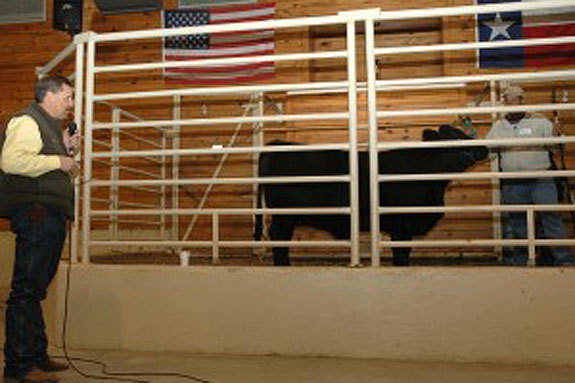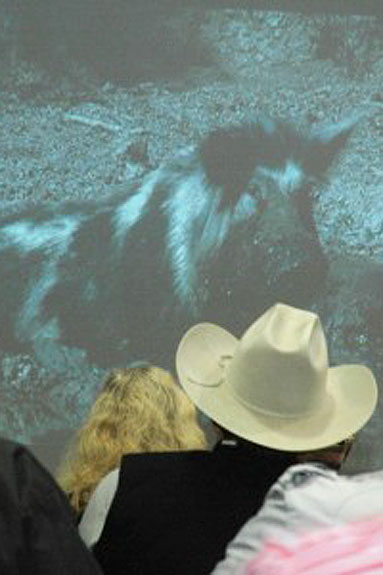
“When it rains, we all look smart,” said Dr. Jason Cleere, Texas A&M AgriLife Extension Service beef cattle specialist from College Station, who moderated the event. “There’s quite a bit of difference between last year and this year.”
What’s different is a bumper crop of weeds across parts of Texas, and the trick to fend them off is to get to them early, said Dr. Paul Baumann, AgriLife Extension state weed specialist, College Station.
“From here to Dallas, there are a number of fields you can’t see a sprig of Bermuda because of all of the dove weed,” Baumann said.
When these weeds are at this growth stage, Baumann said they form an umbrella and not only “are they sucking up water, they are also intercepting sunlight which is critical for bermudagrass growth.”
Baumann said to keep in mind “for every pound of weeds you control, you gain at least a pound of forage in return.”
'“The key is to get the job done early on annual broadleaf weeds,” Baumann said. “Annual weeds have limited root systems and are easier to control than perennial weeds.”
Baumann said this time of year is not the time to control warm season annual broadleaf weeds, such as doveweed or broomweed.
“By the time they have flowered, they have picked your pocket,” he said.
Products such as 2,4-D and Grazon P+D can provide control. Mechanical shredding is an option, but has to be done early and expense has to be factored, Baumann said.
“The longer you let weeds compete with forage grass, the longer they are going to detract from forage production,” he said.
For annual weeds, Baumann suggests spraying at four to six inches in height. “If they get larger, they will require more herbicide and will have detracted more from forage production,” he said.
Regarding perennial weeds, mechanical shredding will only get a top kill, Baumann said.
Herbicides are much more effective on perennial weeds such as silverleaf nightshade or Carolina horsenettle.
 Meanwhile, Doug Pierce, division chair for agriculture at Blinn College, provided tips on basic beef cattle selection. He said skeletal soundness and body volume are key basic criteria to be used in profitable cattle selection.
Meanwhile, Doug Pierce, division chair for agriculture at Blinn College, provided tips on basic beef cattle selection. He said skeletal soundness and body volume are key basic criteria to be used in profitable cattle selection.
As a side note, Pierce noted that an often overlooked “real world” criteria is width of muzzle or “wide-mouthed cattle.”
Pierce said he prefers wide-mouthed cows that are capable of consuming large amounts of forage like a machine.
“A cow is nothing more than Mother Nature’s hay baler,” he said. “The kids always laugh at me at Blinn when I say I like a cow with a wide mouth. She’s like a machine and width of muzzle always (allows) her to harvest and process more forage in a day – like a hay baler.”
Pierce said a cow must have the correct type of muscle or “beef” surrounding this sound skeleton.
“Muscle is what we sell in the beef industry,” said Pierce, but this muscle has to be designed in a way to facilitate fluid movement of the cow, not inhibit it.
“A good cow with skeletal soundness and proper body depth is capable of consuming large volumes of forage (if available) daily and produce beef,” he said.
In a live cattle demonstration, Pierce discussed in great detail what ranchers should be looking for when purchasing replacement cattle. Some points to keep in mind include evaluating how a cow stands, whether or not they are post-legged or buck-kneed and the length of neck.
“Shoulder angularity and its effect on neck length is a good indicator of skeletal soundness,” he said.

Feral hog biology and control methods were also discussed by Dr. Jim Cathey, AgriLife Extension wildlife specialist and associate department head for wildlife and fisheries sciences at Texas A&M University.
Cathey told attendees that female feral hogs are prolific breeders, cycling every 18 to 24 days if not already bred.
“They are just built to get little pigs out there in the wild,” he said.
Males average 180 pounds in weight, while females average 150 pounds. Feral hogs generally run in groups with the female adult hogs called “sounders.” Cathey said it’s estimated there are 2.6 million feral hogs in Texas.
“Imagine how much more beef cattle or bobwhite quail we could have if we didn’t have this many feral hogs in our state?” he said. “We’ve got too many of them and we need to (get) rid of them.” ![]()
—From Texas A&M AgriLife Extension Service
PHOTOS
PHOTO 1: Dr. Jason Cleere, Texas A&M AgriLife Extension Service beef cattle specialist, moderated the event.
PHOTO 2: Dr. Paul Baumann, Texas A&M AgriLife Extension Service state weed specialist, provided weed control strategies.
PHOTO 3: Doug Pierce, division chair for agriculture at Blinn College, provided tips on basic beef cattle selection.
PHOTO 4: The feral hog, a nemesis to Texas ranchers, was one of the featured topics at this year’s South Central Texas Cow Calf Clinic in Brenham. Texas A&M AgriLife Extension Service photos by Blair Fannin.






